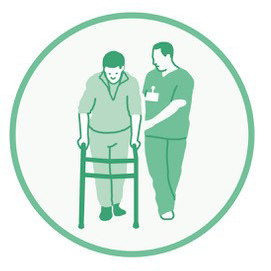Heat and summer smog strain the human organism, harmful germs multiply faster in water and in food, the spread of harmful organisms can trigger allergies or transmit diseases. Humans are not the only ones affected. Heat and drought pose new challenges for livestock farming. The negative health consequences of climate change clearly outweigh the positive effects.


The following overview shows the most important risks and opportunities for human and animal health based on the Confederation’s climate change analysis completed in 2017. Risks and opportunities for individual parts of the country are addressed in the section Major regions.
Legend:
[R] Risks of climate change
[C] Opportunities due to climate change
[?] Areas for which a clear assessment is not yet possible
[R] Impacts of hotter and sunnier weather on health and efficiency
- Decline in well-being at high temperatures
- More frequent illnesses and deaths from heat waves, among others in elderly or fragile persons and infants
- Increase in respiratory ailments and illnesses as well as cardiovascular diseases in stable high-pressure situations with greatly increased ozone levels (summer smog)
- Increased risk of skin cancer due to more intense sunlight
- Reduced performance- and concentration in workplaces where high temperatures prevail
[R] Increased risks due to allergens and infectious diseases
- Spread of allergenic plants, prolonging the season for pollen-induced allergies (hay fever, asthma, etc.)
- Increased occurrence of diseases transmitted by ticks, mosquitoes and other animals
- Spread of ticks – and thus the risk of FSME and Lyme disease infections – in higher altitudes
- Increased occurrence of diseases caused by germs in the water or spoiled food
[R] New risks for animal health and reduced income from livestock farming
- Decline in the well-being livestock due to heat stress
- Losses due to the heat-related decrease in productivity and fertility (livestock husbandry)
- Increased occurrence of infectious diseases and their carriers such as mosquitoes from warmer areas
- Additional costs for bridging bottlenecks on pasture grasses and drinking water due to drought
[C] Positive effects on human health
- Decline in illness and death caused by cold (e.g., hypothermia, cardiovascular and respiratory diseases)
- Fewer accidents on snow and ice
- Decreasing risk of infections from the tick-borne FSME virus at lower altitudes, especially South of the Alps
[?] Uncertain impacts
- Increases or decreases in the numbers of deaths, injuries and dependent persons due to storms
Last modification 22.12.2023
Contact
Federal Office for the Environment FOEN
Reporting and Adaptation Section
Papiermühlestr. 172
3063 Ittigen





